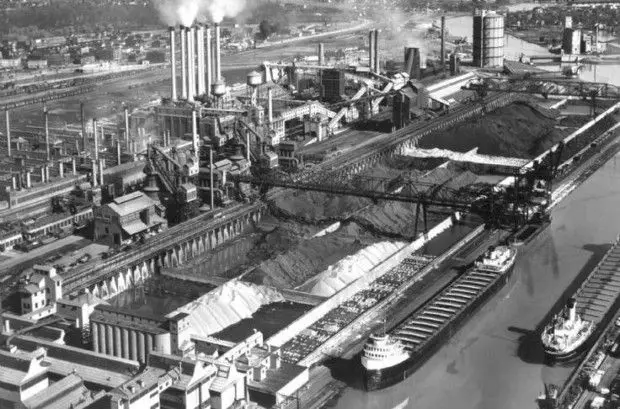The Rust Belt Cities, once a symbol of America’s automotive glory, is experiencing a remarkable transformation. Cities that once relied heavily on manufacturing are now evolving into vibrant hubs of innovation and creativity. This shift not only aims to revive the local economies but also enhances the quality of life for residents, making these areas more appealing to new businesses and visitors alike.

As the economic landscape changes, many cities are adopting urban regeneration strategies to attract talent and investment. These efforts include revitalizing infrastructure, promoting cultural amenities, and fostering community engagement. Examples of successful revitalization can be seen in towns that have embraced their historical roots while forging new paths in technology and tourism.
The future outlook for these communities is encouraging, as they continue to leverage their unique histories to build sustainable economies. The Rust Belt renaissance illustrates the resilience of these cities and their ability to reinvent themselves in a rapidly shifting world.
Key Takeaways
- Rust Belt cities are moving from decline to revitalization through innovation.
- Urban renewal strategies are key to attracting new businesses and residents.
- Historical significance plays a vital role in shaping future economic success.
Historical Context

The Rust Belt’s transformation is deeply rooted in its historical evolution as a manufacturing powerhouse. This section examines the rise and fall of manufacturing within these cities, the effects of globalization and deindustrialization, and the demographic changes impacting population dynamics.
Rise and Decline of Manufacturing
During the early to mid-20th century, the Rust Belt was a vital center for manufacturing in the United States. Cities like Detroit, Cleveland, and Pittsburgh thrived on jobs related to automotive production, steel, and machinery. The region attracted millions with good-paying jobs and solid infrastructure.
However, by the late 20th century, energy costs, competition, and technological advancements led to factory closures. Many manufacturing jobs disappeared, leaving a significant economic void. The decline of this industry starkly marked the shift towards a new economic reality in these areas.
Impacts of Globalization and Deindustrialization
Globalization has played a critical role in the decline of Rust Belt cities. Companies sought to cut costs by moving operations overseas where labor was cheaper. This led to a rapid loss of jobs in manufacturing sectors.
Deindustrialization followed closely behind, as factories closed and entire communities faced economic challenges. This reduced the skilled workforce in the area, making it difficult for cities to adapt. The shift highlighted the vulnerability of a region heavily reliant on a single industry.
Demographic Shifts and Suburbanization
Population decline has significantly impacted the Rust Belt. As manufacturing jobs left, many residents sought opportunities elsewhere, leading to a falling population. The exodus of skilled workers created a void in local economies.
At the same time, suburbanization changed the landscape. Families moved to suburban areas in search of better living conditions and schools. This shift strained urban infrastructure and left many Rust Belt cities struggling with vacant properties and lower tax revenues. The demographic changes continue to affect growth and development strategies in these regions.
Economic Evolution

The Rust Belt is undergoing significant economic changes. Cities that once thrived on manufacturing are now adapting their economies. This shift focuses on innovation, technology, and collaboration to address challenges and create new opportunities.
Shift to Knowledge Economy and Technology
Rust Belt cities are moving towards a knowledge economy. This change involves greater emphasis on technology and information-based jobs. Cities are attracting tech companies and startups by fostering innovation hubs.
In places like Detroit, initiatives support the growth of technology firms. Programs that promote research and development are crucial. Companies now seek skilled workers who can handle advanced tasks.
Key industries include:
- Information Technology
- Biotechnology
- Green Technology
The focus on education and training is essential for this transition. Universities partner with local businesses to provide relevant skills.
Diversification of Economic Sectors
Gone are the days when the Rust Belt relied solely on manufacturing. Cities are diversifying their economies to include various sectors. This strategy helps reduce reliance on any single industry, boosting resilience.
Key sectors include:
- Healthcare
- Renewable Energy
- Tourism
By encouraging entrepreneurship, cities create new business opportunities and jobs. Emerging industries are vital for attracting investment and stimulating growth.
For example, cities are developing amenities that promote tourism. They also support small businesses that contribute to local culture and economy.
Role of Public-Private Partnerships
Public-private partnerships (PPPs) are central to economic transformation in the Rust Belt. These collaborations bring together government resources and private sector expertise.
PPPs can fund infrastructure development and community projects. They enhance job creation and skill training programs. An example is the renovation of abandoned factory spaces into innovation centers.
These partnerships also focus on attracting new businesses. When local governments support startups, they foster a thriving business climate.
Investing in educational initiatives through PPPs is crucial. It ensures local workers have the skills needed for new industries.
In conclusion, the Rust Belt’s economic evolution illustrates the power of adaptability and collaboration in creating a sustainable future.
Urban Regeneration Strategies

Urban regeneration in former Rust Belt cities involves several key strategies aimed at fostering community growth and improving living conditions. Effective approaches include community-led initiatives, infrastructure investment, and a focus on education for upward mobility.
Community-Led Development Initiatives
Community-led development initiatives empower residents to shape their neighborhoods. This approach often involves citizens in planning and decision-making processes. Local organizations may offer resources and training to encourage participation.
These initiatives help address specific community needs, such as creating parks or enhancing public spaces. Residents are more likely to advocate for projects that reflect their interests and culture. Moreover, engaging locals promotes a sense of ownership, reducing the risk of displacement and gentrification.
Examples include neighborhood associations and grassroots organizations that focus on improving safety, amenities, and housing conditions. Such efforts support social cohesion and enhance the overall quality of life.
Investing in Infrastructure and Housing
Investment in infrastructure is critical for urban regeneration. This includes upgrading roads, public transport, and utilities. Enhanced infrastructure attracts businesses and encourages economic activity.
Affordable housing is another essential component. As cities transform, housing costs can rise rapidly, leading to displacement. To combat this, cities are developing mixed-income housing projects that keep neighborhoods diverse.
Collaboration with private developers can also be beneficial. Incentives for building affordable units ensure that long-standing residents are not pushed out. Cities focusing on infrastructure and housing improve not just aesthetics but also accessibility, making communities more livable.
Education and Upward Mobility
Education is vital for upward mobility in revitalized urban areas. Strong educational institutions raise overall skill levels in the community, paving the way for better job opportunities. Investment in schools can attract families seeking quality education for their children.
Partnerships between local businesses and schools can create vocational training programs. These programs help prepare students for careers in growing industries. They also foster connections between young people and employment opportunities.
Access to education helps break the cycle of poverty and creates pathways for residents to elevate their economic status. By focusing on educational improvements, cities lay the groundwork for sustainable growth and development.
Case Studies: Revitalizing Rust Belt Cities

Many former automotive cities are showing remarkable change. These transformations highlight various approaches to economic recovery. Each case study provides insights into effective strategies and the lessons learned through their revitalization.
Pittsburgh: From Steel to Tech
Pittsburgh once thrived as an industrial center for steel manufacturing. The decline of the steel industry prompted the city to seek new economic opportunities. Today, it has emerged as a leader in technology and healthcare.
The establishment of tech firms and startups has fueled job growth. Institutions like Carnegie Mellon University have played a key role by fostering innovation. This focus on education has attracted talent and investment, moving the city away from its industrial past.
A booming healthcare sector also contributes significantly to the economy. Organizations such as UPMC have expanded, creating thousands of jobs. Through these efforts, Pittsburgh exemplifies how a city can successfully pivot from its industrial roots.
Small Town Success Stories
Small towns in the Rust Belt are finding unique paths to revitalization. Communities are emphasizing local entrepreneurship and innovative industries. Many are tapping into their historical assets, creating tourism opportunities.
For example, towns are redeveloping old factories into art and cultural centers. These hubs attract visitors and new residents. Local programs are supporting small businesses, providing resources for startups.
Communities are also leveraging their natural resources. Outdoor recreational activities and eco-tourism are being promoted. These efforts showcase the distinct character of each town and help retain local populations.
Urban Transformation Lessons Learned
The revitalization of Rust Belt cities offers valuable lessons. A strong focus on education and workforce development is essential. Cities that encourage collaboration between local businesses and educational institutions often see greater success.
Additionally, engaging community members in planning is vital. When residents feel included, they invest in their community’s future. This collaboration can lead to innovative solutions tailored to local needs.
Lastly, diversifying the economy ensures resilience against future declines. Cities that provide support for various industries create a more stable job market. By learning from these case studies, other cities can adapt successful strategies for their own revitalization efforts.
The Social Dimension

The social aspects of the Rust Belt Renaissance are vital to creating healthier communities. Addressing challenges like income inequality and gentrification helps ensure that all residents benefit. At the same time, fostering cultural diversity and community resilience is key to revitalizing these formerly industrial cities.
Addressing Income Inequality and Gentrification
Income inequality is a significant issue in many Rust Belt cities. As these areas reinvent themselves, disparities can widen. New investments often lead to gentrification, pushing out long-time residents who can no longer afford rising costs.
To combat this, local governments and organizations are promoting equity in development. They aim to create affordable housing and support small businesses owned by locals. Programs that offer job training in emerging industries also help bridge economic gaps.
Balancing growth while preserving community character is crucial. Engaging residents in planning processes builds trust and ensures that development reflects their needs. Without careful management, revitalization efforts may deepen social divides.
Fostering Cultural Diversity and Community Resilience
Cultural diversity plays a key role in the resilience of Rust Belt communities. As cities transform, various cultural expressions can emerge, enriching the social fabric. Celebrating this diversity strengthens community ties and fosters belonging.
Local festivals, art fairs, and cultural events allow residents to share their heritage. These activities not only promote understanding but also attract visitors, boosting the local economy. Additionally, community centers often serve as hubs for cultural exchange.
Community resilience is strengthened through collaborative efforts. Residents working together can better respond to challenges, whether economic or social. Organizations focused on fostering connections between different groups are essential for long-term success in these evolving cities.
Future Outlook

Cities in the Rust Belt are taking important steps toward a stronger future. They focus on sustainability while planning economic growth and urban policies. By addressing environmental issues and ensuring resilience, these cities aim for a vibrant, recovering economy.
Sustainability and Environmental Considerations
Sustainability is a key focus for Rust Belt cities. Many are adopting green infrastructure and renewable energy sources. This shift helps cities reduce their carbon footprints and become more resilient.
For example, Detroit is investing in urban green spaces and energy-efficient buildings. These initiatives not only improve air quality but also enhance community well-being. Cities are recognizing the need for cleaner transportation options, including electric public transit systems and bike lanes.
Community involvement is essential for these transformations. Local residents are encouraged to participate in planning and decision-making. This collaboration fosters a sense of ownership and responsibility toward environmental stewardship.
Economic Forecasts and Policymaking
Economic forecasts show promising recovery in Rust Belt cities. Policymakers are focused on attracting new businesses and investments. They are creating incentives for companies that focus on innovation and technology.
For instance, Columbus, OH, has been recognized for its efforts in supporting startups and tech firms. Urban policies that prioritize job creation in emerging industries are crucial for sustainable growth.
Additionally, targeted investments in infrastructure are vital. Improved transportation systems and affordable housing can stimulate local economies. Resilient economic strategies will help these cities thrive despite challenges, paving the way for a robust future.
Global and Comparative Perspectives

The experiences of Rust Belt cities in the United States can provide valuable lessons when compared to similar economic shifts in Europe and North America. Understanding how different regions adapt to economic challenges can help guide these former automotive hubs toward a more resilient future.
Learning from Economic Models in Europe and North America
European cities such as Manchester and Turin have successfully transitioned from manufacturing to diversified economies. They invested heavily in education and technology. This has fostered innovation and attracted new businesses.
In contrast, many former automotive cities in North America faced significant economic challenges after the decline of manufacturing. They can adopt strategies such as partnerships with local universities to create a skilled workforce. Public-private partnerships can also help revive local economies by funding infrastructure improvements.
A notable example includes the transformation of the once-industrial city of Pittsburgh. It shifted from steel production to technology and healthcare. This model shows that by diversifying their economic base, Rust Belt cities can build resilience against future economic downturns.
Adapting to a Post-NAFTA Economic Landscape
The North American Free Trade Agreement (NAFTA) significantly impacted manufacturing jobs in the Rust Belt. After its implementation, many companies moved operations abroad for cheaper labor. This shift resulted in economic dislocation for many workers.
In response, Rust Belt cities need to focus on local manufacturing and invest in automation and advanced technologies. By doing so, they can create competitive advantages while keeping jobs in the region.
Moreover, supporting small businesses and startups can stimulate local economies. Policies that encourage entrepreneurship will help adapt to a landscape shaped by globalization and international trade.
By examining these factors, cities can learn to navigate the economic shifts that have challenged them and work toward a sustainable future.
Frequently Asked Questions

Many former automotive cities in the Rust Belt are taking innovative steps to reinvent their economies. They focus on attracting new industries, enhancing their identities, and fostering sustainable growth.
What strategies are former automotive cities implementing for economic reinvention?
Former automotive cities are adopting various strategies for economic change. They are diversifying their economies by attracting tech companies and startups. This shift helps reduce reliance on traditional manufacturing jobs.
How has the identity of Rust Belt cities evolved in recent years?
The identity of Rust Belt cities has shifted towards a more vibrant and dynamic status. Residents and leaders are embracing a mix of history and modernity. This transformation is reflected in community pride and cultural initiatives.
What role does innovation play in the revitalization of Rust Belt economies?
Innovation is crucial for revitalizing Rust Belt economies. Many cities are focusing on technology, green energy, and sustainable practices. These initiatives create new jobs and attract a younger workforce.
Which industries are leading the resurgence in Rust Belt regions?
Key industries driving resurgence in Rust Belt regions include healthcare, technology, and advanced manufacturing. These fields are providing new opportunities and strengthening the local economy. Additionally, industries focused on renewable energy are emerging as significant contributors.
How are Rust Belt cities attracting new business and talent?
Rust Belt cities are enhancing quality of life to attract new business and talent. They are improving infrastructure, supporting education, and offering tax incentives. These efforts create an appealing environment for both companies and workers.
What are the long-term goals of Rust Belt cities for sustainable growth?
Long-term goals for Rust Belt cities include creating resilient economies and sustainable communities. They aim to invest in education and workforce training. These steps ensure that residents can thrive in changing job markets.
See also: The Rust Belt



